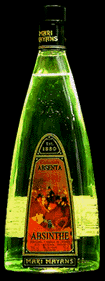
How it is made
The roots of absinthe are in a Greek infusion of wormwood leaves and other herbs in wine. This potent mixture was used to ease women's menstrual pains and rheumatism. Dr. Ordinaire (a French expatriate in Switzerland) took this idea and gave it fuel injection. His Absinthe was a distilled version using wormwood, juniper, lots of anise and some other herbs. This absinthe was highly potent and evidently tasted strongly of licorice.
The modern absinthe is still stronger and created by
an infusion of herbs into pure alcohol which is then diluted.
Making
home made absinthe is highly unsafe and in most countries illegal.
Absinthe is also known as the green goddess or the green fairy. It has quite a cultural pedigree with such great names as: Degas, Toulouse La-Trec, Picasso, Van Gogh, Oscar Wilde and Hemmingway.
The most well known manufacture of absinthe was Henri-Louis Pernod in France throughout the late 19th century. In the early 20th Century in France it was observed that heavy absinthe drinkers had an inclination to violence, suicide and insanity. This led to the definition of "absinthism" as a new from of alcoholism and by 1915 absinthe was banned in France due to the thujone content on which this effect was blamed. The high alcohol content of course could have had nothing to do with the effect! It was also banned in the USA, Belgium and Switzerland.
Absinthe has remained legal in the UK. There are many
stories trying to explain why absinthe was not banned. The most likely
explanation is that absinthe was a high class drink in the UK. In the
UK Absinthe was not associated with the working class or down and outs
rebelling so no one saw the need to ban it
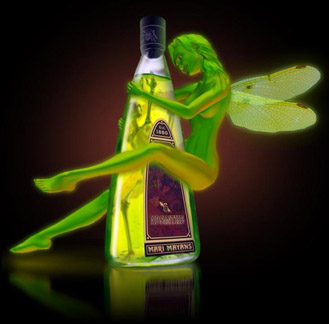
image created by Mark Meloche
Absinthe was
allegedly invented by Dr. Pierre Ordinaire in 1792, as an all-purpose
remedy.
Used as a cure-all, it was nicknamed "La Fée Verte" or "The Green Fairy"; a nickname that has stuck.
Artemisia Absinthiumwas used " in medicine and magic. . .to rouse a
languid appetite and stimulate digestion"
Ironically, Absinthe originally treated drunkenness though it
was often added to wine "to
make it more intoxicating".
The name "La Fée Verte" is associated with magic, mythology and provocatively intoxicating female
figures.
This long history of magical associations with
wormwood and its powers worked to
popularise Dr. Ordinaire's concoction, and to heighten Absinthe's
popularity and mystical appeal.
The plant has been recognised for centuries (the
Egyptians called it Saam)
but Dr. Ordinaire probably used a recipe
from the sisters Henriod at the beginning of the 19th century. By 1805,
the Pernod-Fils absinthe company
was set up in Pontarlier, France, by Henri-Louis
Pernod.

The popularity of the drink spread
further, as it was used as a fever preventative by French troops
fighting in Algeria from 1844-1847.
When the troops returned to France, they brought with them their taste
for the anisette drink.
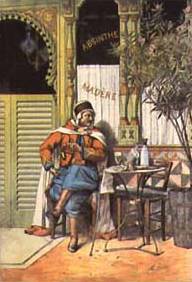
Absinthe hit its peak during the years from
1880-1914, named the "great collective
binge".
Absinthe is a symbol of inspiration and daring, associated with the artistic
life,
and is sometimes used as an aphrodisiac.
Absinthe drinking was "one of the special marks of
Parisin the 1890s; "the drink
of Parisian abandon".
In 1874 the French consumed 700 thousand litres of Absinthe, by 1910 it
rose to 36 million litres of Absinthe per year.
It was also exported to New Orleans, where it quickly became extremely
popular,
but Americans' enjoyment of The
Green Fairy was cut short when
United States health officials imposed a ban
on the drink in 1912.

This ban followed the examples set by
Holland, Belgium, Brazil and other countries.
France was last to ban, finally prohibiting absinthe after a long
series of debates, in 1915.
Still, the drink remained so popular that it continued to be sold
(sometimes in disguised form,
one of the more unusual being in hair tonic bottles) as late as the
1920's and 1930's.
It has never been illegal in Spain or the United Kingdom to make, sell
or drink Absinthe.
The Absintheur's love affair with the drink
begins with an interesting courtship:
Sugar is
placed on a spoon and suspended over a tall glass
filled with a shot of green Absinthe.
Then ice-cold water is dripped over the sugar
and allowed to fall in beads into the drink.
Each drip turns to a fresh snow-packed white.
The sugar cuts the Absinthe's bitterness,
while the method was attractive in itself,
the drink's change in colour, drip by drip, resembles alchemy.
The New
Orleans Old Absinthe House was famous for its Absinthe fountain,
which dripped water into the glasses automatically.
Absinthe is also drunk in a variety of
personalised ways. Toulouse-Lautrec
made a special concoction
called un tremblement de terre(earthquake), which combined Absinthe and
brandy.
Absinthe can be served with red or white wine instead of water,
or drunk straight by the purist.
In "For Whom the Bell Tolls" Ernest Hemingway writes "...one cup of it took the place of the
evening papers,
of all the old evenings in cafes, of all chestnut trees that would be
in bloom now in this month...".
Oscar Wilde added: "The first stage is like
ordinary drinking, the second when you begin to see monstrous
and cruel things, but if you can persevere you will enter in upon the
third stage where you see
things that you want to see, wonderful curious things". Wilde goes
on to explain how, during this third stage,
one imagines tulips and simultaneously feels them brushing against
one's shins.
In the cheerful atmosphere of recovery that
followed the Franco-Prussian War, l'heure verte "the green hour"
became an established daily event. Because of a generally increased
liberal attitude in France
and relaxed policies for opening cabarets and cafés in France during
the 1860s, almost 366 thousand existed
in Paris by 1869, and 5 p.m. signified l'heure verte in almost every one.
The cafés were an extremely popular place to socialize; by the 1870s,
it became common practice
to preface a meal with a cheap aperitif, and of 1500 available liqueurs,
Absinthe accounted for 90% of the apéritifs drunk.
For those more interested in flouting
authority absinthe is closely identified with counterculture.
Absinthe is romanticized and captured in artwork and writings by, Van Gogh, Verlaine, Rimbaud,
Baudelaire, Oscar Wilde,
Ernest Hemingway, Picasso, and
many others. It almost seems as if there was
no artist who lived during the "great
collective binge" who did not
revel in Absinthe.
All these artists were exemplary of an alternative life style.
Degas' famous 'L'Absinthe' (1876) pictures two forlorn-looking
café-squatters staring, dishevelled,
out beyond their opaline drinks. Although the people pictured were merely actors,
this painting later
roused intense Francophobia in England.
Manet, however, dared to paint an actual street
bum with Absinthe, titled 'The
Absinthe Drinker' (1859).
The man leans on a wall, vacuous-eyed and bundled in rags.
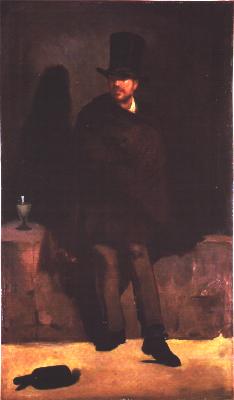
Manet’s work signified the beginning of modernist
realism in painting,
and thus, Absinthe and a movement against the mainstream are
linked in his work.
Even more unusually, VanGogh
(introduced to absinthe by Toulouse-Lautrec and Gauguin)
painted many of his works in ochres and pale greens, which are the
colors of Absinthe.
Many of these paintings also depict the bar in which Van Gogh drank
Absinthe,
and himself with glasses of the apéritif.
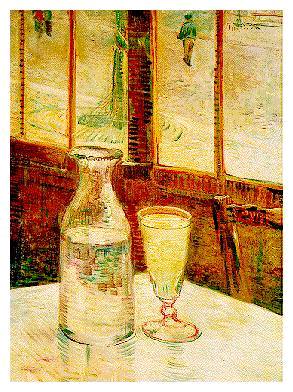
The history of Absinthe lends credence to the
conviction that if something is too good,
it will eventually be stopped. Absinthe was banned because of the fear of the
drink's counter-culture
revolutionary aspect; Absinthe is "a symbol of the bohemian spirit".
Absinthe had its own slang, which is attractive to those in the know
and undeniably irritating,
if not terrifying, to those who are not.
Absinthe has recently regained popularity in the
United Kingdom;
As we approach the next decade the thirst for Absinthe will grow as people
search for new
recreational experiences at home, in bars and clubs.
At the forefront of this
growth lies Mari
Mayans Absenta which is
establishing itself as the most
palatable and interesting materialisation of the drink's long history.
It is time the green fairy be let out and allowed to fly freely
through the bars of the world once again,
adding mystique, intrigue and something slightly timeless to modern culture.
Absinthe
1.5 oz Wormwood
1/3 oz Hyssop
1/3 oz Calamus Root
1/8 oz Fennel Seed
1 tsp Mint *
1 tsp cloves *
1 tsp coriander *
1/2 tsp Nutmeg *
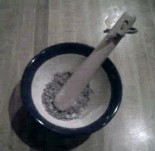 First, Grind the
Fennel Seeds,
Coriander, and Cloves with a mortar and pestle.
First, Grind the
Fennel Seeds,
Coriander, and Cloves with a mortar and pestle.Mix with the rest of the dry ingredients (wormwood, hyssop, calamus, and mint) and pour them into an airtight container. Mix with a bottle of Everclear (750ml, 190 proof). Actually, if you want to end up with a full 750ml of Absithe, you'll need to use about 1000ml of everclear in order to compensate for the alcohol that is irrevocably lost to absorption by the mash. You should allow mix to steep for at least two weeks, but I usually allow for 1-2 months. This is most likely overkill, but I don’t drink absinthe on a regular basis so I’m not generally in a big hurry to finish my next batch.
At the end of the two weeks, strain the liquid through a thin cloth (muslin or a handkerchief) to remove the solid matter.
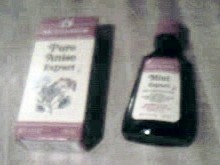 Now Add:
Now Add:1/2 Dropper full of Wormwood Essential Oil.*
1/3 - 2/3 Bottle of Anise Extract (To taste)
1 tsp Mint Extract *
2-10 shots Ouzo* (To taste)
Now you're ready to meet the green fairy!
If Everclear is unavailable, I've heard tat rum 151 will suffice - although I've never tried it myself. However, regular-strength alcohols (less than 100 proof) will not work! - Your absinthe will turn out brown. Ack!
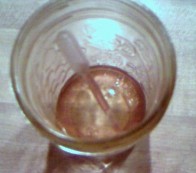 The ingredients
marked with a
"*" are not completely necessary, but will help make the drink more
palatable. (It needs all the help it can get!) If you wish, you can mix
this absinthe half-n-half with Ouzo and obtain a drink that tastes
halfway descent, but you'll lose some of the potency of the drink. The
best way to improve the taste is to add more anise extract, but even
this has its limits.
The ingredients
marked with a
"*" are not completely necessary, but will help make the drink more
palatable. (It needs all the help it can get!) If you wish, you can mix
this absinthe half-n-half with Ouzo and obtain a drink that tastes
halfway descent, but you'll lose some of the potency of the drink. The
best way to improve the taste is to add more anise extract, but even
this has its limits.If you add more calamus, you will get a better buzz -- but this will come at a price. I used to use 1/2 oz of calamus in my earlier recipes -- but I would end up with a 12-hour hangover the next day. I eventually figured out that the calamus was to blame, and cut back on it a bit. But of course, feel free to experiment with it yourself!
Now for the hard part... Drinking it.
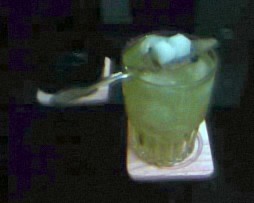 I would not advise
drinking
this recipe 'neat'. In its pure form, it is extremely nasty, extremely
potent, not to mention extremely explosive (It is 190 proof,
after all!)
I would not advise
drinking
this recipe 'neat'. In its pure form, it is extremely nasty, extremely
potent, not to mention extremely explosive (It is 190 proof,
after all!)I normally drink it the traditional way. Fill a glass with ice. Pour 1 shot of Absinthe into the glass. Set 2 sugar cubes on a slotted spoon (or fork) over the glass. And finally, SLOWLY pour cold water over the cubes to dissolve the sugar into the absinthe. Be sure to pour ONLY the water over the cubes. If the cubes soak up the Absinthe they will dissolve more slowly. I have found that it also helps to "pre-soak" the cubes on the spoon for about 10-15 seconds before you pour in the rest of the water.
But the most important thing to remember is -- Don't let the first sip scare you away! That first gulp is always the worst. The moment this ultra-bitter stuff hits the tongue, it will send you into a cartoon-character-like convulsion. But I can assure you -- Your taste buds will eventually de-sensitize to the point that this nasty swill almost tastes good! Absinthe is definitely an acquired taste.
Also remember that it doesn't matter how much you drink -- That licorice flavor will linger in your mouth for hours. Once you commit to that first drink, you might as well see it through. And I promise, by the time you finish that 3rd glass you won't care about the taste. Well... at least you wont care as much!!
-------------------------------------------------------------------------------------------------------------------
(f) = fresh herb
wormwood artimesia absinthium was used through out, and all of the ingredients where crushed or bruised within the liquid used before being left to steep
Vodka recipe 1
1 large leaf of wormwood (f)
1 inch liquorice stick crushed
1 star anise
small pinch of fennel (f)
small amount of angelica
quarter tsp. aniseed
half a litre of shirmnof black label
The liquorice star anise and half of the vodka where mixed about a week before adding the rest of the herbs, including wormwwood, and the other half of the vodka. As this was experimental only about half a litre was made. After a week steeping on a warm sunny window ledge, the mixture was strained. It was a tan colour with a slight greenish tinge, if held to the light. It was quite bitter, with a slight after taste. I don't know if this one improves with age as it was drunk within 2 weeks
Vodka and Vanilla
1 large leaf of wormwood (f)
green tops of fennel (f)
a vanilla pod
1 star anise
pinch of dried oak
lemon balm (f)
half a litre of shirmnof black label
Again only half a litre was made, as these where all experimental. The star anise and half of the vanilla pod where added to half of the vodka about a week before adding the rest of the ingredients to the bottle. This was also left to steep on a sunny window ledge for a week. This has a darker hue after straining than the previous recipe but has a much mellower taste, due largely to the vanilla. After 5 months this is considerably smoother with a noticable vanilla taste and a more bitter under tone, and after taste, from the wormwood.
Vodka recipe 2
1 large leaf of wormwood (f)
1 inch liquorice
1 star anise
2 juniper berries
quarter tsp. ground nutmeg
quarter tsp. aniseed
pinch of ground cloves
half a litre of shirmnof black label
Another experimental one, again to half of the vodka the juniper
berries star anise nutmeg and liquorice where added a week before the
rest of the ingredients. However the juniper berries where removed just
prior to adding the wormwood and other spices. This had a less
noticable greenish tinge than the first recipe but was not as dark as
the second. Initially the most bitter and harshest of the 3 recipes
tried, this has adged well, and after 5 months now has a similair taste
to commercial absinthe. Although still the "wrong" colour and not
nearly as alcoholic.
TNT
2/3 Absinthe
1/3 Hennessy VSOP
Splash Cointreau
Angostura bitters
Stir over ice strain and Serve Garnish with an orange wedge
--------
Absinthe pousse-cafe flambe
6-layers:
1. grenadine
2. butterscotch schnapps
3. blue curacao
4. creme de banana
5. creme de menthe
6. absinthe
Flame on!
--------
Desire
1/4 Absinthe
1/2 tablespoon sugar
3/4 lemon juice
Shake well and pour into cocktail glass...
--------
Sazerac
1/splash Absinthe
2/splashes Bourbon
1/splash sugar syrup
3/splashes Peychaud bitters
3/splashes Angosturas bitters
Shake over ice and serve...
Traditional Method
1 teaspoon of simple syrup (or 1 sugar cube or 1 teaspoon of granulated sugar)
3 dashes Peychaud's bitters
2 ounces cognac
splash of Absinthe
Strip of lemon peel
--------
Absinth Eye
1/3 peppermint
2/3 Absinthe
Shake well and pour into cocktail glass...
--------
Atomic Bomb
1/2 Absinthe
1/2 brandy
Stir and pour into cocktail glass...
--------
Absolution
1/splash Absinthe
2/splashes Krupnik (honey liquor)
3/splashes ginger cordial
Fresh lime juice, orange juice, apple juice.
Shake over ice - charge with ginger...
--------
Absint curacao frappe
1 oz. Absinthe
1/2 oz. curacao
1 teaspoon lemon juice
2 teaspoons orange juice
1 thin sliceorange
Stir ingredients and pour over crushed ice in a deep-saucer champagne glass.
Add orange slice...
--------
Knock Out
1 teaspoonful white Creme de Menthe
1/3 Absinthe
1/3 dry gin
1/3 French vermouth
Shake well and pour into cocktail glass...
--------
ABSINTHE FIZZ
1.5 oz. Absinthe
Juice of 1/2 Lemon
1 Tsp. Sugar
1 Egg White
Seltzer
Shake with ice and strain into a highball glass and fill with seltzer...
--------
BECHER SPRINT
1 part Absinthe
1 part tonic
1cl of Grenadine
2 part sparkling wine/wine
Garnish and Ice
--------
BECHEROVKA MIMOSA
1 part Absinthe
2 parts Champagne
2 parts freshly squeezed orange juice
--------
RED BECHEROVKA
1 part Absinthe
3 parts Grapefruit juice
Splash of Cranberry juice
--------
BECHER CLUB - COCKTAIL
1 part Absinthe
1 part grapefruit juice
1 part orange juice
1.5 parts Vermouth Bianco
--------
BECHEROVKA PARIS
1 part Becherovka
2 part brandy (or Cognac)
Cherry (on stick)
--------
WHARF RAT
1 part of white rum
1 part of Grenadine
1 part of Absinthe
1 part of Apricot brandy
3 parts of orange juice
Mix with crushed ice and top it up with Absinthe.
--------
TRAFFIC LIGHT
2 parts of cranberry juice
1 part of orange juice
1 part of Absinthe
Pour carefully into a cocktail glass half filled with ice.
--------
GREEN TEAR
1 part of Absinthe
2 parts of cranberry juice
1 part of Indian tonic water
1 slice of lemon
Shake well and pour into a cocktail glass.
--------
ABSINTHE BOLLYSIDE
1 part of Absinthe
1/2 part of Jack Daniels
1/2 of Gin
1/4 of Archers Peach Schnapps
1 part of Red Bull
Drop of cranberry Juice
+
| Disclaimer:
The following is for informational
purposes only. Some of the substances mentioned here can be toxic and
may result in injury and very nasty hangovers. Please consult reliable
medical information before attempting to ingest the substances listed
here. Continued use of absinthe can result in addiction, convulsions,
and possibly death -- that's what they say. |